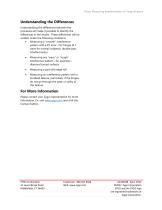 Website:
Zygo
Website:
Zygo
Group: Ametek
Catalog excerpts

APPLICATION NOTE Phase Measuring Interferometry vs. Fringe Analysis There are analytical and practical differences between fringe analysis and phase measuring interferometry. This application note describes these differences and their effects on a measurement. Interference patterns can be analyzed using several different methods. The two most common are fringe analysis and phase measuring interferometry. There are fundamental differences between these two methods, and subsequently differences should be expected in the results calculated, such as peak-to-valley (PV) or root-mean-square (rms). Careful operator technique should minimize the differences, but some are due to the nature of the part under test and the interferometer itself. Phase measuring interferometry is the more accurate technique. There are several reasons for this: What is Fringe Analysis This technique relies on comparing the shape of the interference fringes to an ideal set of fringes. Usually this means a set of straight, parallel, equally spaced fringes. The shape of the fringe is found by locating the centers of the dark fringes. What is Phase Measuring Interferometry? This is a dynamic process which calculates the interference phase at every point in the interference pattern. These interference phases are then connected together to form a map which is then compared to an ideal map. Usually this is a plane. Higher density sampling of the interference pattern (and therefore the part) Uniform sampling of the interference pattern Better phase resolution (<0.001 fringe sensitivity) Measurements can be made at the null alignment condition, which minimizes optical errors due to imaging distortion and raymapping (shear) errors In contrast, fringe analysis is impacted by: Sampling of data only along the dark fringes— both uniform and low density. This risks missing localized features (bumps or holes) in the interference pattern Phase resolution >0.0001 fringe Interferometer must be misaligned in order for fringes to be visible Fringe analysis forces the user into making a tradeoff between interferometer alignment (few fringes) and sampling of the part (man
Open the catalog to page 1
Phase Measuring Interferometry vs Fringe Analysis Understanding the Differences Understanding the differences between the processes will make it possible to identify the differences in the results. These differences will be evident under the following conditions. Measuring a “smooth” interference pattern with a PV error <0.2 fringes (0.1 wave for normal incidence, double-pass interferometry) Measuring any “wavy” or “rough” interference pattern—for example— diamond turned surfaces Measuring a part with edge roll Measuring an interference pattern with a localized feature, particularly if...
Open the catalog to page 2All Zygo catalogs and technical brochures
-
Zygo Nano Position Sensors
20 Pages
-
Zygo Precision Optics & Systems
20 Pages
-
Zygo Laser Interferometers
28 Pages
-
Zygo 3D Optical Profilers
24 Pages
-
Zygo Service Brochure
12 Pages
-
Compass2 1-sheet - Optimized
2 Pages
-
Compass 2™ Specifications
2 Pages
-
Mx Surface Texture Parameters
28 Pages
-
SubAngstrom Surface Texture
3 Pages
-
Mx Films Analysis Software
2 Pages
-
Interferometer Scale Facton
2 Pages
-
Coherent Artifact Reduction
3 Pages





















